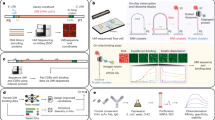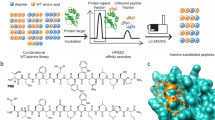Abstract
OUR aim was to improve techniques for drug development by facilitating the identification of small molecules that bind with high affinity to acceptor molecules (for example, cell-surface receptors, enzymes, antibodies) and so to mimic or block their interaction with the natural ligand1,2. Previously such small molecules have been characterized individually on a serial basis. The systematic synthesis and screening of peptide libraries of defined structure represents a new approach. For relatively small libraries, predetermined sequence variations on solid-phase supports have been used3,4, and large libraries have been produced using a bacteriophage vector into which random oligodeoxynucleotide sequences have been introduced5–8, but these techniques have severe limitations. Here we investigate an alternative approach to synthesis and screening of peptide libraries. Our simple methodology greatly enhances the production and rapid evaluation of random libraries of millions of peptides so that acceptor-binding ligands of high affinity can be rapidly identified and sequenced, on the basis of a "one-bead, one-peptide9 approach.
This is a preview of subscription content, access via your institution
Access options
Subscribe to this journal
Receive 51 print issues and online access
$199.00 per year
only $3.90 per issue
Buy this article
- Purchase on SpringerLink
- Instant access to full article PDF
Prices may be subject to local taxes which are calculated during checkout
Similar content being viewed by others
References
Hruby, V. J., Al-Obeidi, F. & Kazmierski, W. Biochem. J. 268, 246–262 (1990).
Hruby, V. J. & Sharma, S. D. Curr. Opin. Biotech. 2, 599–605 (1991).
Geysen, H. M., Melven, R. H. & Barteling, S. J. Proc. natn. Acad. Sci. U.S.A. 81, 3998–4002 (1984).
Fodor, S. P. et al. Science 251, 767–773 (1991).
Parmley, S. F. & Smith, G. P. Gene 73, 305–318 (1988).
Scott, J. K. & Smith, G. P. Science 249, 386–390 (1990).
Cwirla, S. E., Peters, E. A., Barrett, R. W. & Dower, W. J. Proc. natn. Acad. Sci. U.S.A. 87, 6378–6382 (1990).
Devlin, J. J., Panganiban, L. C. & Devlin, P. E. Science 249, 404–406 (1990).
Niall, H. D., Tregear, G. W. & Jacobs, J. in Chemistry and Biology of Peptides, (ed. Meienhofer, J.), 695 (Ann Arbor, Michigan, 1972).
Author information
Authors and Affiliations
Rights and permissions
About this article
Cite this article
Lam, K., Salmon, S., Hersh, E. et al. A new type of synthetic peptide library for identifying ligand-binding activity. Nature 354, 82–84 (1991). https://doi.org/10.1038/354082a0
Received:
Accepted:
Issue Date:
DOI: https://doi.org/10.1038/354082a0
Comments
By submitting a comment you agree to abide by our Terms and Community Guidelines. If you find something abusive or that does not comply with our terms or guidelines please flag it as inappropriate.



